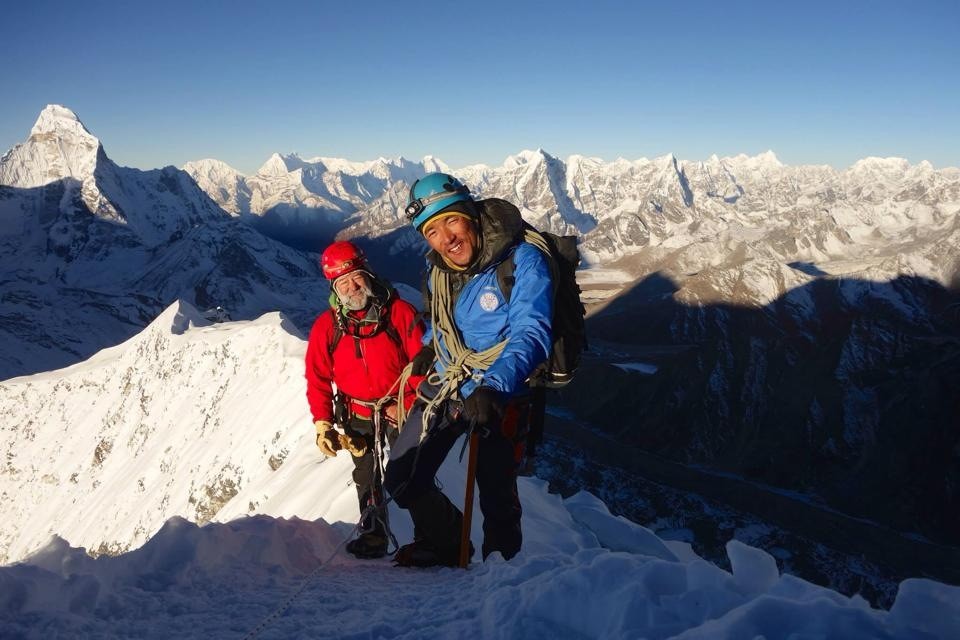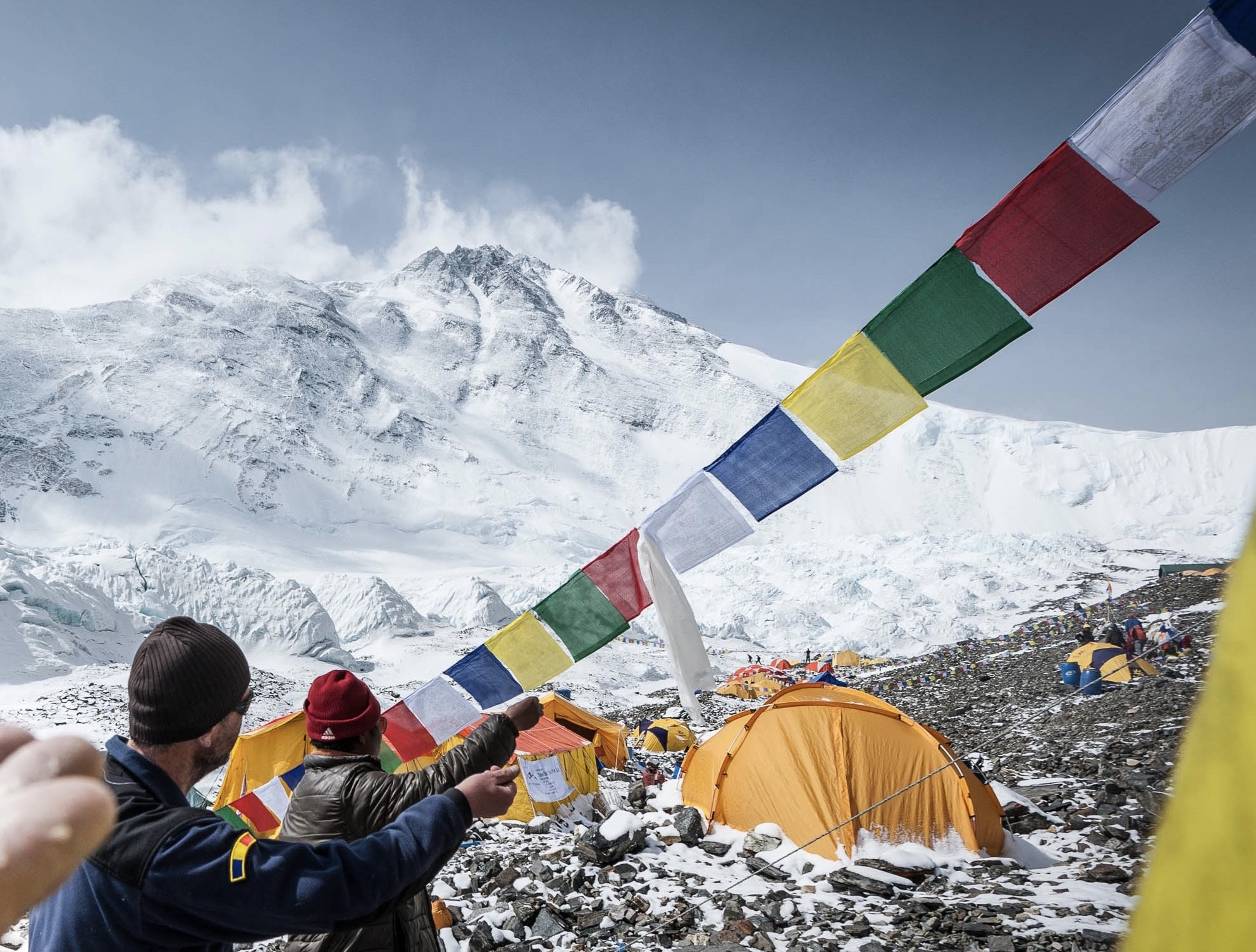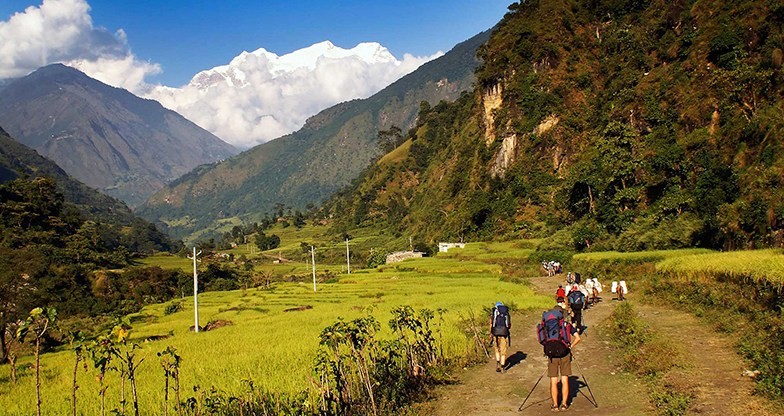

Island Peak, also known as( Imja Tse) is a mountain in the Himalayas of eastern Nepal. Island Peak Climbing with Everest Base Camp trek allows us to experience ultimate adventure in the popular Everest region of Nepal. This exciting yet delightful and adventurous trekking and Island peak climbing adventure offer the chance to observe excellent panoramic up-close views of Everest Himalayan ranges like Lhotse, Nuptse, Makalu including Everest, and other surrounding peaks from popular viewpoints like Gokyo Ri and Kalapathher. Likewise, summiting Island peak is simply a once in lifetime of adventure.
Island Peak climbing with Everest Base Camp Trek is designed for those adventurer seekers who are energetic and physically fit and wish for both trekking and climbing experiences in one go. Island Peak Climbing doesn’t require technical climbing knowledge and experience, however, you must be in good physical shape with a passion for walking, exploring, and basic climbing skills.
Our Island peak climbing itinerary has been designed very professionally by taking care of proper and gradual acclimatization at suitable intervals. Before scaling the peak, we also take you to possibly the most popular trekking destination in the world – Everest Base Camp and Kala Patthar – for the up-close views of Mt. Everest and other high mountains.
Trip Highlight
DAY
1
DAY
2
DAY
3
DAY
4
DAY
5
DAY
6
DAY
7
DAY
8
DAY
9
DAY
10
DAY
11
DAY
12
DAY
13
DAY
14
DAY
15
DAY
16
DAY
17
DAY
18
DAY
19
DAY
20
Trip Start: 2025-04-15
Trip End: 2025-05-06
spots available
Trip Start: 2025-10-20
Trip End: 2025-11-09
spots available
Having the right equipment on your adventure trips will make almost as much difference to your success, safety, comfort, and enjoyment as any physical training you do. It is essential that you take the time to acquire the correct gear; don’t wait for the last minute to find out your local shop doesn’t have your size. This equipment is expensive, but you can often find great sales online and at your local gear store. The purpose of this gear list is to help guide your purchases.
This list is a guide. While you are required to bring everything on this list, there are numerous options, brands, and versions of each piece of equipment, unless otherwise noted. Using our current suggested brand list we encourage you to shop around, do research, use your experience and the listed features to find the best gear for you.
During your time in the mountains, you will encounter a very wide range of temperatures and weather conditions. At one end of this range is the pleasantly warm and beautiful low land, while at the other end of the spectrum is found the cold and often windy weather of the highest peaks in the world. The equipment you bring must function well in a wide variety of conditions. Your clothing should be warm, lightweight, dry quickly, and allow good freedom of movement. The layering principle, based on several thin layers of insulation
(rather than one thick one), covered with an outer weatherproof shell, meets these needs well.
A Note on Packing
For your international flights, we recommend that you pack all your equipment in your two duffle bags. Do not simply pack your backpack (since the straps can be damaged by the baggage handling machines). It is important to lock these bags for their trip. Depending on the airport, you may be able to put your travel locks on after TSA has searched the bags. If not, Lock the bags with Zip Ties. If the TSA cuts off the zip-tie to search your bag, they will replace it. You will still need the travel locks to lock your bags in the hotel and during the expedition. Generally, you will take one duffel up to Base Camp, and leave one in the hotel in Kathmandu with your belongings for your time in the city. Your trek in duffel will only be accessible in the evenings (with items such as changes of clothing, sleeping bag), and your day pack will hold vitals such as water, layering, blister kit, and camera.
Important Notes:
Tips:
Clothing
Footwear
Handwear
Headwear
Climbing Gears
Backpacking
Accessories
Hygiene and first aid
Others
Conclusion:
As the weather condition is unpredictable in the Himalayan region, you need to be prepared at all times. A day can start sunny with clear skies and later become cold and windy at the high altitudes.
Sometimes, it can rain and snow during the trekking period. You need to remember that for a successful trekking journey, your physical comfort must be the first priority.
Note:
Please note that these items listed above will vary according to the season, trek duration. Please remember that your luggage will be carried by the porter, but you need to carry a daypack on your own. We also suggest you pack only necessary items to keep the weight of your equipment to a minimum. Carrying a day pack only applies to the trekkers who take full package with us and those who take only guide they should bring the bag big enough to carry their own stuff. If you have any questions, please do not hesitate to contact us at your convenience.
1
The best time to climb Island peak is Autumn and Spring season. These seasons have very ideal climate and weather for Island peak climbing. The weather is stable with clear visibility of the views. But, this expedition is possible during the Winter and Monsoon season as well.
2
Island peak climb is basically recommended for beginners willing to step into the world of mountaineering. Even then, climbing the Island peak requires having the experience of trekking in a high altitude. Island peak is a difficult climb at an extreme altitude. The foot of the headwall is the toughest part of the climb. The ascent is very steep and the air at its thinnest. However, the climbing route is safe because of fixed lines.
3
Grading: 7-8 (Strenuous), Alpine PD+ Climbing Island peak is considered strenuous due to longer duration trek/climb in a remote and isolated area that goes above 5500m. You need to sleep at an elevation of 5000m+ for multiple days. Climbers are required to have an excellent physical level with fierce determination. Daily walking hours include 6-7 hrs on average and summit day can be 10-14 hrs long. This grade trip involves the usage of climbing equipment (Harness, Ice Axe, Crampons, Mountaineering Boots, Ascender). Previous experience is essential and we also provide a climbing course at base camp before the actual climb where your guides will teach you the proper way to use the equipment.
4
High altitude treks and climbs especially in the Himalayas are challenging and require you to be in the top physical, emotional, and psychological condition. The more fitter you are, the more enjoyable your trip will be. Do daily physical workouts (jogging, hiking, cycling, gym, etc) prior to a couple of weeks. Climbing conditioning – pack-loaded uphill hiking, walking, and stair climbing. Strength training – for the lower body and core. Cardiovascular training – including both aerobic and anaerobic workouts without pack weight. Flexibility training.
5
Bringing out typical tastes of peak climbing in Nepal, both Island Peak and Mera Peak have their own set of peculiarities. Mera Peak is slightly higher than Island Peak while Island Peak, with more steep ice climbs, is considered a little more technical than Mera Peak. There are some significant differences in the climbing aspects of Climbing. While both peaks do not require specific mountaineering skills, many other factors differentiate these two peaks. Mera Peak is deemed the easier one to climb from the safety point, whereas in terms of adventure Island Peak offers more thrills of mountain climbing
6
Mt. Everest is not visible from the summit of Island peak as the peak is tucked behind the shoulders of Mt. Lhotse. However, you can marvel at the magnificent views of Mt. Ama Dablam, Mt. Lhotse, and Mera Peak.


